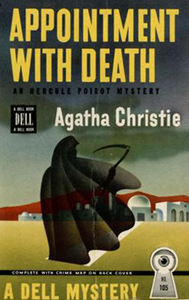Building off the interest in psychology displayed in “Cards on the Table” (1936), Agatha Christie digs further into that science in “Appointment with Death” (1938). But this time she lets the reader be the psychologist.
The first half of the book barely has Poirot in it, for the sake of one overheard conversation but largely so we know the detective will factor into the story later. But mostly we get to see how the American Boynton family, on vacation in the Middle East, is ruled by the petty tyranny of its matriarch.
The terrifying Mrs. Boynton
Christie does some of her best character writing to this point by showing the control Mrs. Boynton exerts on her children of different ages: The fully grown Lennox has largely given up; and younger adults Raymond and Carol think they should fight back soon lest youngest child Jinny succumbs to the mother’s power.

“Appointment with Death” (1938)
Author: Agatha Christie
Genres: Mystery, family drama
Series: Hercule Poirot No. 18
Settings: Jerusalem, Israel; Petra, Jordan; 1938
We observe the Boyntons through the voyeuristic gaze of fellow vacationers Sarah King, a newly minted doctor, and Dr. Gerard, a veteran psychologist. Romance plays an engaging role in “Appointment,” as Sarah becomes interested in saving Raymond.
Another traveler, Mr. Cope, has long had eyes for Lennox’s wife, Nadine, who is mulling giving up on her milquetoast husband. A British politician, Lady Westholme, and her doting friend, Miss Pierce, are also on hand.
Poirot enters the picture
In part two, “Appointment” perfectly mixes Poirot’s observations of everyone’s behavior and traits with the traditional charms of a Christie novel, like when Poirot calls each witness into his hotel room, chapter by chapter, for their account of the day of Mrs. Boynton’s death.
The author comes up with a neat playing field for the murder, too: a valley in Transjordania featuring a marquee (a large gathering tent where meals are served) along with assorted individual tents and caves.
Mrs. Boynton lords over it all from a chair at the lip of her cave, but she’s 200 yards away from the heart of the action, so it’s not clear if she’s alive or dead as she sits there, unmoving – a rather creepy image.
It’s remarkable how Christie works in a seemingly formulaic genre – indeed, Poirot tells Colonel Carbury how things would play out if this were a fictional murder mystery – yet comes up with fresh angles. Here, we’re drawn into a study of how people can be ruled by another person even without physical abuse or restraint.
As a bonus, we get a hint of the investigators’ value systems. Carbury and Poirot probe the mystery with the understanding that they may not be able to prove anything in court – after all, the Boynton family likely features a mess of people lying to protect one another. Yet both feel it’s worth the effort to know the truth.

Does it matter if the victim is a villain?
The fact that the murder victim was a horrible person is another interesting wrinkle, as we wonder if that makes a moral difference to Poirot. Christie hasn’t forgotten that a similar situation occurred in “Murder on the Orient Express,” and while Poirot claims that case was different, as readers we know it wasn’t that much different.
The line the Belgian detective draws between justifiable and unjustifiable murder becomes quite blurry when comparing his approaches here and in that 1934 classic.
But Christie lets Poirot off the hook; he isn’t forced to confront his (arguable) hypocrisy. Still, I’m happy that she engages with the idea for a while; maybe she’ll go deeper in a future novel.
Perhaps even more impressive than Christie finding a new starting point (psychological profiling) is that she closes with a traditional yet surprising flourish. Poirot gathers everyone together to outline his discarded theories before arriving at the reveal of whodunit, and I was hanging on every word even more so than usual.
This might’ve been a difficult one to sort out, as many characters’ behavior and accounts are based on their belief that someone they love is the killer. But Christie writes with clarity and verve.
“Appointment with Death” is both a fresh (in the first half) and a familiar (in the second half) Poirot yarn, crafted with precision on both counts. It merits consideration on any list of Christie’s elite novels.
Every week, Sleuthing Sunday reviews an Agatha Christie book or adaptation. Click here to visit our Agatha Christie Zone.

